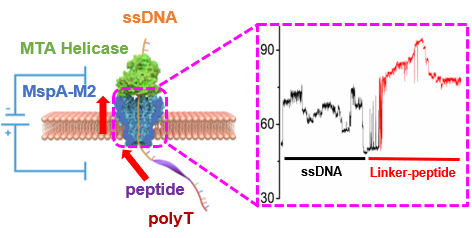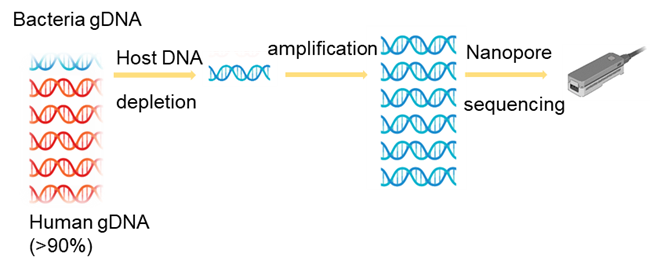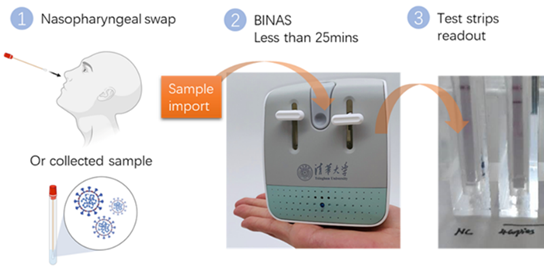Research Interests:
The new generation of DNA sequencing technology is based on the strategy of single-molecule real-time sequencing, which aims to rapidly identify and determine the base sequence on single molecular nucleic in a continuous manner. The representative nanopore technology can directly sequence DNA and RNA molecules, with sequencing fragments reaching tens of thousands of bases or more. It has advantages such as small instrument size, fast sequencing speed, and simple library preparation. It complements the NGS technology, further expanding the application of DNA sequencing in pathogen microbiome monitoring, genomic structural variation, epigenetic modifications, protein sequencing, and other fields. Our research group mainly focuses on the developing fundamental sequencing technologies based on nanopore platforms and exploring the clinical application of this type of long-read sequencing technology.:
1) Fundamental study of nanopore sensing and sequencing platform: Our primary focus is the evolution of core nanopore proteins and strategy of single-molecule translocation control. Utilizing advanced motor proteins, we are investigating the movement and interactions of linear biopolymers, including nucleic acids, peptides, and polysaccharides, inside nanopores. This could lead to a new biopolymer sequencing technology or a method for exploring protein-protein interactions.

2) Clinic application of nanopore based long-read DNA sequencing: The primary focus of the research is on the sample preparation and library construction method suitable for nanopore based long-read DNA sequencing platform for the application of metagenomics study, single cell research, and diagnosis of cancer and infection disease.

3) Point-of-Care nucleic acid detection technique: Developing high sensitivity and rapid isothermal amplification methods for nucleic acids, as well as visually detectable colorimetric techniques, can enable fast on-site high sensitivity pathogen detection without the need for complex instruments.

Selected Publications:
1. S. Li†, B. Li†, X. Li†, C. Liu†, X. Qi, Y. Gu, B. Lin, L. Sun, L. Chen, B. Han, J. Guo, Y. Huang, S. Wu, L. Ren, J. Wang, J. W. Bai*, J. Ma*, M. Yao*, P. Liu*, An ultrasensitive and rapid “sample-to-answer” microsystem for on-site monitoring of SARS-CoV-2 in aerosols using “in situ” tetra-primer recombinase polymerase amplification. Biosensors and Bioelectronics (2023) 219, 114816.
2. H. Zhang†, L. Zhao†, J. Jiang†, J. Zheng†, L. Yang, Y. Li, J. Zhou, T. Liu, J. Xu, W. Lou, W. Yang, L. Tan, W. Liu, Y. Yu, M. Ji, Y. Xu, Y. Lu, X. Li, Z. Liu, R. Tian, C. Hu, S. Zhang, Q. Hu, Y. Deng, H. Ying, S. Zhong, X. Zhang, Y. Wang*, H. Wang*, J. W. Bai*, X. Li*, X. Duan, Multiplexed nanomaterial-assisted laser desorption/ionization for pan-cancer diagnosis and classification. Nat. Commun. (2022) 13, 617.
3. Z. Chen†; Z. Wang†; Y. Xu; X. Zhang; B. Tian; J. W. Bai*, Controlled movement of ssDNA conjugated peptide through Mycobacterium smegmatis porin A (MspA) nanopore by a helicase motor for peptide sequencing application, Chemical Science, 2021, 47, 15750-15756.
4. B. Wang, Y, Sun, H. Ding, X. Zhao, L. Zhang, J. W. Bai*, K. Liu*, “Bioelectronics‐Related 2D Materials Beyond Graphene: Fundamentals, Properties, and Applications”, Adv. Funct. Mater. (2020), 30, 2003732.
5. R. Tian*, Y. Li, J. W. Bai*, “Hierarchical assembled nanomaterial paper based analytical devices for simultaneously electrochemical detection of microRNAs”,Analytica Chimica Acta, (2019) 1058,89-96.
6. R. Tian, W. Ning, M. Chen, C. Zhang, Q. Li, J. W. Bai*, “High performance electrochemical biosensor based on 3D nitrogen-doped reduced graphene oxide electrode and tetrahedral DNA nanostructure”, Talanta, 2019,194,273-281.
Patents
1) J. W. Bai, J. Du,Y. Xu “Nucleic acid sequencing method” ZL 202011289898.0, WO2022105640A1.
2) J. W. Bai, Z. Chen, “Method for controlling speed of polypeptide passing through nanopore and use thereof” ZL201910580964.0, CN112147185B, US20220365094A1, EP3955002A4, WO2021000786A1.
3) J. W. Bai, Z. Liu, “Flexible device and preparation method thereof, flexible device assembly and application”, ZL 202110518870.8
4) J. W. Bai, J. Du, Z. Chen, “A kind of methods and applications forming film” ZL 201811337111.6



